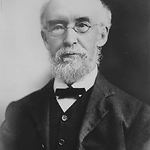Person
Jamieson, James (1840 - 1916)

Jamieson, James Portrait
Details
- Born
- 5 June 1840
Beith, Ayrshire, Scotland - Died
- 1 August 1916
- Occupation
- Physician
Summary
James Jamieson was President of the Royal Society of Victoria in 1901. In 1868 Jamieson moved to Australia and set up a practice in Warrnambool, Victoria. He was also health officer to the municipality and honorary medical officer at the hospital. Jamieson promoted germ theory, better hygiene, the use of disinfectants, and isolation of the inflicted to battle infectious disease. In 1877 Jamieson moved to Melbourne. He was honorary physician in the outpatient department of the Melbourne Hospital in 1879-1884, then joined the senior staff at the Alfred Hospital, retiring in 1908. In 1885 he succeeded T. M. Girdlestone as health officer of the City of Melbourne. Jamieson also lectured at the University of Melbourne (MD ad eundem gradum, 1878) in obstetrics and diseases of women and children in 1879-1887, and in the theory and practice of medicine in 1887-1908.
Details
Chronology
- 1862
- Education - Doctor of Medicine (MD), University of Glasgow
- 1863
- Education - Master of Surgery (ChM), University of Glasgow
- 1868
- Life event - Migrated to Australia (Warrnambool, Victoria)
- 1868 - 1877
- Career position - Health Officer, private practice and Honorary Medical Officer at the Warrnambool Hospital
- 1879 - 1884
- Career position - Honorary Physician in the outpatient department of the Melbourne Hospital
- 1879 - 1887
- Career position - Lecturer in obstetrics and diseases of women and children, University of Melbourne
- c. 1884 - 1908
- Career position - Senior Physician at the Alfred Hospital
- 1885 - 1912
- Career position - City Health Officer in Melbourne
- 1887 - 1908
- Career position - Lecturer in theory and practice of medicine, University of Melbourne
- 1900
- Career position - President, Section I (Sanitary Science and Hygiene), Australasian Association for the Advancement of Science
- 1901
- Career position - President, Royal Society of Victoria
Related entries
Published resources
Encyclopedia of Australian Science and Innovation Exhibitions
- Collins, David, Chemistry in 19th Australia - Select Bibliography, An exhibition of the Encyclopedia circa 2005 with assistance from Ailie Smith and Gavan McCarthy., eScholarship Research Centre (original publisher), Melbourne, 2009, https://eoas.info/exhibitions/ciab/ciab_ALL.html. Details
Book Sections
- Dunstan, David, 'Jamieson, James (1840-1916), Medical Practitioner, University Teacher and Health Officer' in Australian dictionary of biography: supplement 1580 - 1980, with a name index to the Australian dictionary of biography to 1980, Christopher Cunneen, ed. (Melbourne: Melbourne University Press, 2005), pp. 199-200. http://www.adb.online.anu.edu.au/biogs/AS10246b.htm. Details
Conference Papers
- Dyason, Diana J., 'James Jamieson and the Ladies', in Patients, Practitioners and Techniques: Second National Conference on Medicine and Health in Australia, Melbourne, 1984 edited by Harold Attwood and R. W. Home (Melbourne: Medical History Unit and Department of History and Philosophy of Science, University of Melbourne, a, 1984).. Details
Journal Articles
- Jamieson, James, 'On the value of the guaiacum test for blood.', The Australian Medical Journal, 14 (1869), 295-300. Details
- Jamieson, James, 'On the guaiacum test for blood', The Australian Medical Journal, 14 (1869), 381-382. Details
Resources
- Wikidata, http://www.wikidata.org/entity/Q16059175. Details
- VIAF - Virtual International Authority File, OCLC, https://viaf.org/viaf/227145542571696641162. Details
- 'Jamieson, James (1840-1916)', Trove, National Library of Australia, 2009, https://nla.gov.au/nla.party-512883. Details
Digital resources
Joanne Evans
Created: 24 August 2000, Last modified: 22 November 2019
- Foundation Supporter - Royal Society of Victoria
